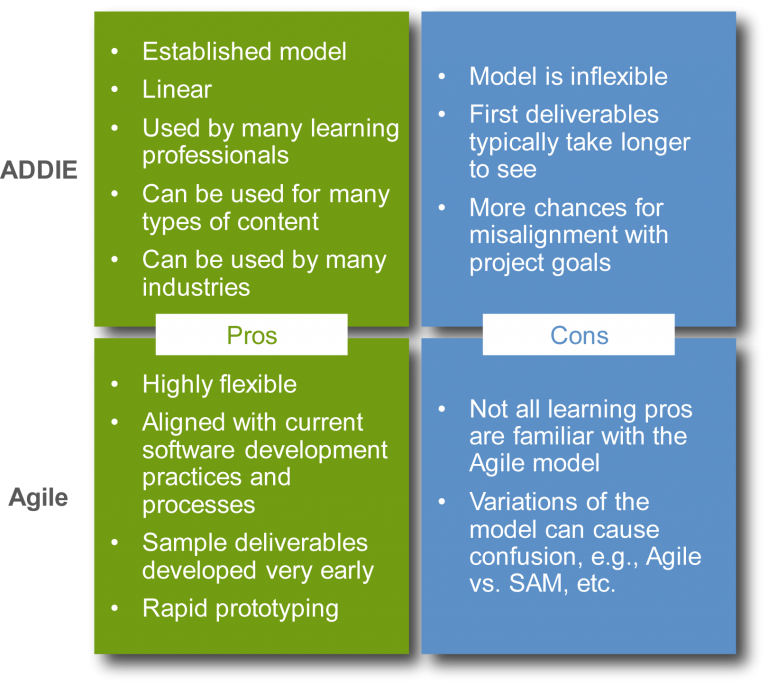An Instructional Design Horror Story
You’re a Director of Sales Training. Your product management team has approached you about three new products being released in the next ten weeks. You’re on the hook to get training created to support the sales professionals who will pitch these new products to prospects and clients. Your regular team of training developers is slammed with other projects and you need to outsource some of the training to external training suppliers. They come well-recommended and are on the company vendor list. The problem is that after six weeks of working with them the only thing you’ve seen is a detailed design document. During the seventh week, they finally produce sample training content that is completely off-the-mark. Why did it take seven weeks to see the first samples? Because the suppliers used the traditional ADDIE model instead of an agile development process.
ADDIE
The acronym “ADDIE” is used to define an instructional design process. Each of the letters represents a phase in the process: Analysis, Design, Development, Implementation, and Evaluation. Sign-off should happen in between each of the phases and be used to sustain the content once implemented. ADDIE has its roots in the military and was formalized by Florida State University in the mid-70’s. When used as initially intended, each phase must be completed before moving to the next.
Agile Development Model
Because the ADDIE Model is more than 40 years old and technology, including learning technology, continues to evolve, many organizations are shifting to a process more aligned with the Agile Software Development process. The Agile Development Model for Instructional Design has created its own set of acronyms, including “SAM” which stands for Successive Approximation Model. A core tenet of these models is that after the initial requirements are identified and understood, rapid prototyping and iterative design occur to help streamline the delivery of content and to ensure deliverables meet customer expectations.
Learn more about St. Charles Consulting Group’s Custom Program Design Services
Core Competencies for Agile Instructional Design Professionals
Instructional designers who are comfortable with the ADDIE model can learn to use Agile development techniques. Here are several core competencies for using Agile.
Flexibility - The traditional ADDIE model is a rigorous lock-step process; you can’t proceed to one phase without completing another. With an Agile process, after the initial preparation phase, prototypes are reviewed with the project stakeholders. Multiple iterations can occur, making it much easier to identify issues much earlier in the process.
Collaboration – With Agile design, different people take the lead in phases. For the best learning solution development, real discussion and sharing of ideas and concerns is critical.
Being Okay with Failure - The first prototype of a learning solution is often going to look very different than the functional prototype and the final product. Failing fast is a key to Agile development success.
Process Awareness – If you’ve never developed learning solutions with an Agile methodology before, research the topic as much as you can. There are plenty of books, articles, and blog posts on the subject (see below).
Pros and Cons of ADDIE vs Agile

In Summary
Even though ADDIE has been around nearly forty years, it doesn’t mean there isn’t an opportunity for improvement. Despite the growth of technology and information since ADDIE’s inception, it has remained the same. Many learning professionals are seeing the value of a more flexible and nimble instructional design methodology which aligns with the way new software applications are built. Most importantly, because of the rapid prototyping during an Agile Development Model, customers see sample mockups and deliverables more quickly, which can avert potentially expensive misalignments later.
Books
Leaving ADDIE for SAM: An Agile Model for Developing the Best Learning Experiences, (Allen, 2012)
Rapid Instructional Design: Learning ID Fast and Right, 3rd Edition, (Piskurich, 2015) – Note: while this sounds like a book on Agile development, it is actually on ADDIE.
Written by Larry Durham, Partner, St. Charles Consulting Group

